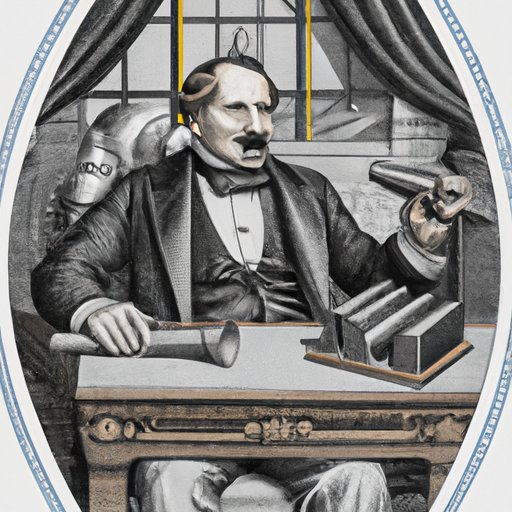Introduction
Steel is a strong, durable, and versatile metal alloy that is made up of iron and carbon. It has been used for centuries to construct buildings, bridges, and other structures that have stood the test of time. Steel can also be found in everyday items such as cars, appliances, and even jewelry. But who invented the steel process? This article will explore the history of steel production, from its early days to modern times, and the man responsible for revolutionizing the iron and steel industry: Henry Bessemer.
A History of Steel: The Inventor of the Steel Process
Steel has been used since ancient times. Early civilizations used it to create weapons, tools, and other objects. Over the centuries, the way steel was produced evolved and improved, with new processes being developed to increase efficiency and reduce costs. But it wasn’t until the 19th century that steel production took a major leap forward.
In 1855, British engineer Henry Bessemer developed a revolutionary process for producing steel. His invention, known as the Bessemer process, allowed steel to be made quickly and cheaply, revolutionizing the iron and steel industry. Thanks to Bessemer, steel could now be mass-produced, making it more accessible and affordable than ever before.

Exploring the Innovations Behind Steel Production
The Bessemer process involves blowing air through molten pig iron to remove impurities, creating steel. This process was incredibly efficient, allowing large quantities of steel to be produced in a single day. The Bessemer process also enabled steel to be manufactured at a fraction of the cost of traditional methods. As a result, steel production soared, with industrialists around the world taking advantage of the new technology.
Over the years, the Bessemer process has been further refined and improved. For example, the introduction of basic oxygen furnaces (BOFs) allowed steel to be produced more quickly and efficiently. Today, steel production is largely automated, with robots and computers taking on many of the tasks previously done by human workers.

Meet the Man Who Revolutionized Steel Manufacturing
Henry Bessemer was born in England in 1813. He studied engineering and metallurgy and was an inventor from a young age. He was granted over 100 patents for his various inventions, including the Bessemer process for producing steel.
Bessemer’s impact on the iron and steel industry was immense. Thanks to his innovations, steel could now be mass-produced, opening up new possibilities for industry and commerce. The Bessemer process revolutionized the steel industry, making steel more accessible and affordable than ever before.
How Henry Bessemer Revolutionized the Iron and Steel Industry
The Bessemer process revolutionized the steel-making process. Before Bessemer’s invention, steel was made by heating and hammering iron ore, a labor-intensive and time-consuming process. The Bessemer process allowed steel to be produced much faster and more efficiently, drastically reducing production costs.
Bessemer’s invention opened up new possibilities for the steel industry. Mass production meant that steel was now available at a lower cost, enabling the construction of larger and more ambitious projects. Steel could now be used for bridges, ships, and other large-scale structures.

Discovering the Impact of Steel in Our Lives
Today, steel is ubiquitous. It can be found in everything from skyscrapers to automobiles. Steel is strong, reliable, and fireproof, making it ideal for a variety of applications. It is also lightweight and easy to work with, making it perfect for a wide range of products. Steel is used in everything from plumbing pipes to kitchen utensils.
The global expansion of steel manufacturing has had a profound impact on our lives. Thanks to steel, we are able to build taller and stronger structures than ever before. Steel also makes it possible to manufacture goods faster and more efficiently, allowing us to enjoy products at a lower cost.
From Invention to Industrialization: The Story of Steel
The story of steel begins with Henry Bessemer and his revolutionary invention. By inventing the Bessemer process, he laid the foundation for the modern steel industry. The Bessemer process was further refined and improved over the years, leading to greater efficiency and lower costs. This, in turn, led to the widespread use of steel and its applications in almost every aspect of life.
Steel has come a long way since its invention in the 19th century. Today, steel is used in a wide range of industries, from construction and manufacturing to transportation and energy. Steel is an integral part of our lives, and its importance will only continue to grow in the future.
Understanding the Steel-Making Process: The Inventor of Steel
Henry Bessemer was a true innovator and his invention changed the world. His groundbreaking process revolutionized the iron and steel industry, making steel more accessible and affordable than ever before. Thanks to Bessemer’s invention, steel can now be produced quickly and efficiently, enabling us to build stronger and safer structures and enjoy products at a lower cost.
Bessemer’s invention of the Bessemer process has had a lasting impact on the world. His legacy lives on in the countless applications of steel in our lives, from cars and bridges to kitchen appliances and jewelry.
Conclusion
Henry Bessemer’s invention of the steel process revolutionized the iron and steel industry and changed the world. His invention allowed steel to be produced quickly and affordably, making it more accessible than ever before. Thanks to Bessemer’s invention, steel can now be used in a wide range of industries and applications, from construction and manufacturing to transportation and energy. The legacy of Henry Bessemer lives on in the countless uses of steel in our lives.
(Note: Is this article not meeting your expectations? Do you have knowledge or insights to share? Unlock new opportunities and expand your reach by joining our authors team. Click Registration to join us and share your expertise with our readers.)
